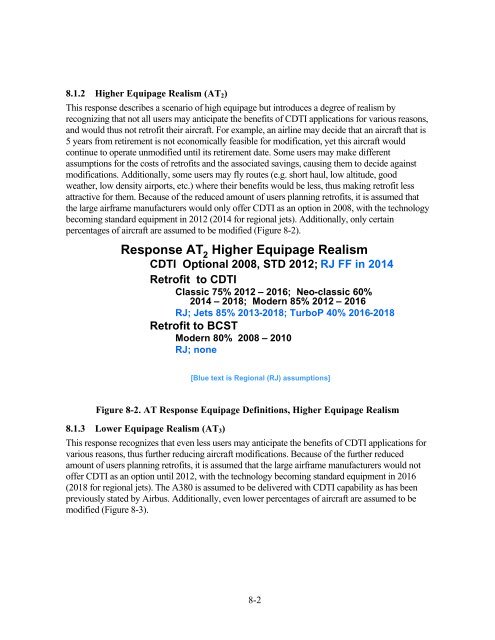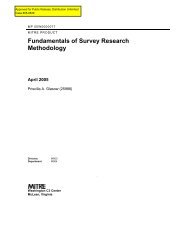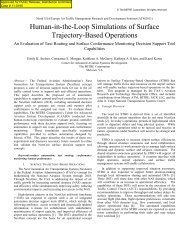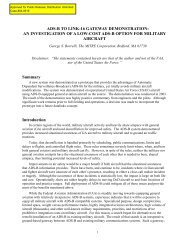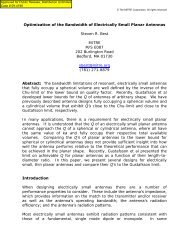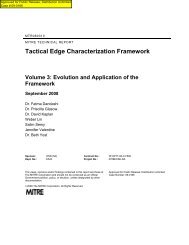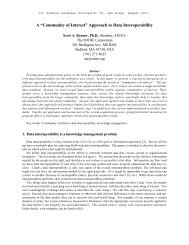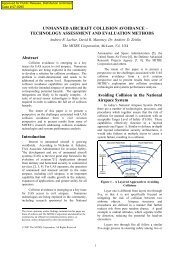A Predictive Model of User Equipage Costs for Future Air ... - Mitre
A Predictive Model of User Equipage Costs for Future Air ... - Mitre
A Predictive Model of User Equipage Costs for Future Air ... - Mitre
Create successful ePaper yourself
Turn your PDF publications into a flip-book with our unique Google optimized e-Paper software.
8.1.2 Higher <strong>Equipage</strong> Realism (AT2)<br />
This response describes a scenario <strong>of</strong> high equipage but introduces a degree <strong>of</strong> realism by<br />
recognizing that not all users may anticipate the benefits <strong>of</strong> CDTI applications <strong>for</strong> various reasons,<br />
and would thus not retr<strong>of</strong>it their aircraft. For example, an airline may decide that an aircraft that is<br />
5 years from retirement is not economically feasible <strong>for</strong> modification, yet this aircraft would<br />
continue to operate unmodified until its retirement date. Some users may make different<br />
assumptions <strong>for</strong> the costs <strong>of</strong> retr<strong>of</strong>its and the associated savings, causing them to decide against<br />
modifications. Additionally, some users may fly routes (e.g. short haul, low altitude, good<br />
weather, low density airports, etc.) where their benefits would be less, thus making retr<strong>of</strong>it less<br />
attractive <strong>for</strong> them. Because <strong>of</strong> the reduced amount <strong>of</strong> users planning retr<strong>of</strong>its, it is assumed that<br />
the large airframe manufacturers would only <strong>of</strong>fer CDTI as an option in 2008, with the technology<br />
becoming standard equipment in 2012 (2014 <strong>for</strong> regional jets). Additionally, only certain<br />
percentages <strong>of</strong> aircraft are assumed to be modified (Figure 8-2).<br />
Response AT 2 Higher <strong>Equipage</strong> Realism<br />
CDTI Optional 2008, STD 2012; RJ FF in 2014<br />
Retr<strong>of</strong>it to CDTI<br />
Classic 75% 2012 – 2016; Neo-classic 60%<br />
2014 – 2018; Modern 85% 2012 – 2016<br />
RJ; Jets 85% 2013-2018; TurboP 40% 2016 -2018<br />
Retr<strong>of</strong>it to BCST<br />
Modern 80% 2008 – 2010<br />
RJ; none<br />
[Blue text is Regional (RJ) assumptions]<br />
Figure 8-2. AT Response <strong>Equipage</strong> Definitions, Higher <strong>Equipage</strong> Realism<br />
8.1.3 Lower <strong>Equipage</strong> Realism (AT3)<br />
This response recognizes that even less users may anticipate the benefits <strong>of</strong> CDTI applications <strong>for</strong><br />
various reasons, thus further reducing aircraft modifications. Because <strong>of</strong> the further reduced<br />
amount <strong>of</strong> users planning retr<strong>of</strong>its, it is assumed that the large airframe manufacturers would not<br />
<strong>of</strong>fer CDTI as an option until 2012, with the technology becoming standard equipment in 2016<br />
(2018 <strong>for</strong> regional jets). The A380 is assumed to be delivered with CDTI capability as has been<br />
previously stated by <strong>Air</strong>bus. Additionally, even lower percentages <strong>of</strong> aircraft are assumed to be<br />
modified (Figure 8-3).<br />
8-2


